Nursing Care Strategy Using Clinical Reasoning Cycle
VerifiedAdded on 2023/04/24
|11
|2747
|494
AI Summary
This case study analyzes the condition of a patient named Mrs. Hale using the clinical reasoning cycle. The report discusses the nursing care given to Mrs. Hale, both professionally and psychologically, and evaluates the causes of her signs and symptoms. The report also focuses on the management of Mrs. Hale’s chest discomfort and analyzes the psychosocial issues in her current life. The report concludes with suggestions for managing health issues and highlights the benefits of using the clinical reasoning cycle.
Contribute Materials
Your contribution can guide someone’s learning journey. Share your
documents today.
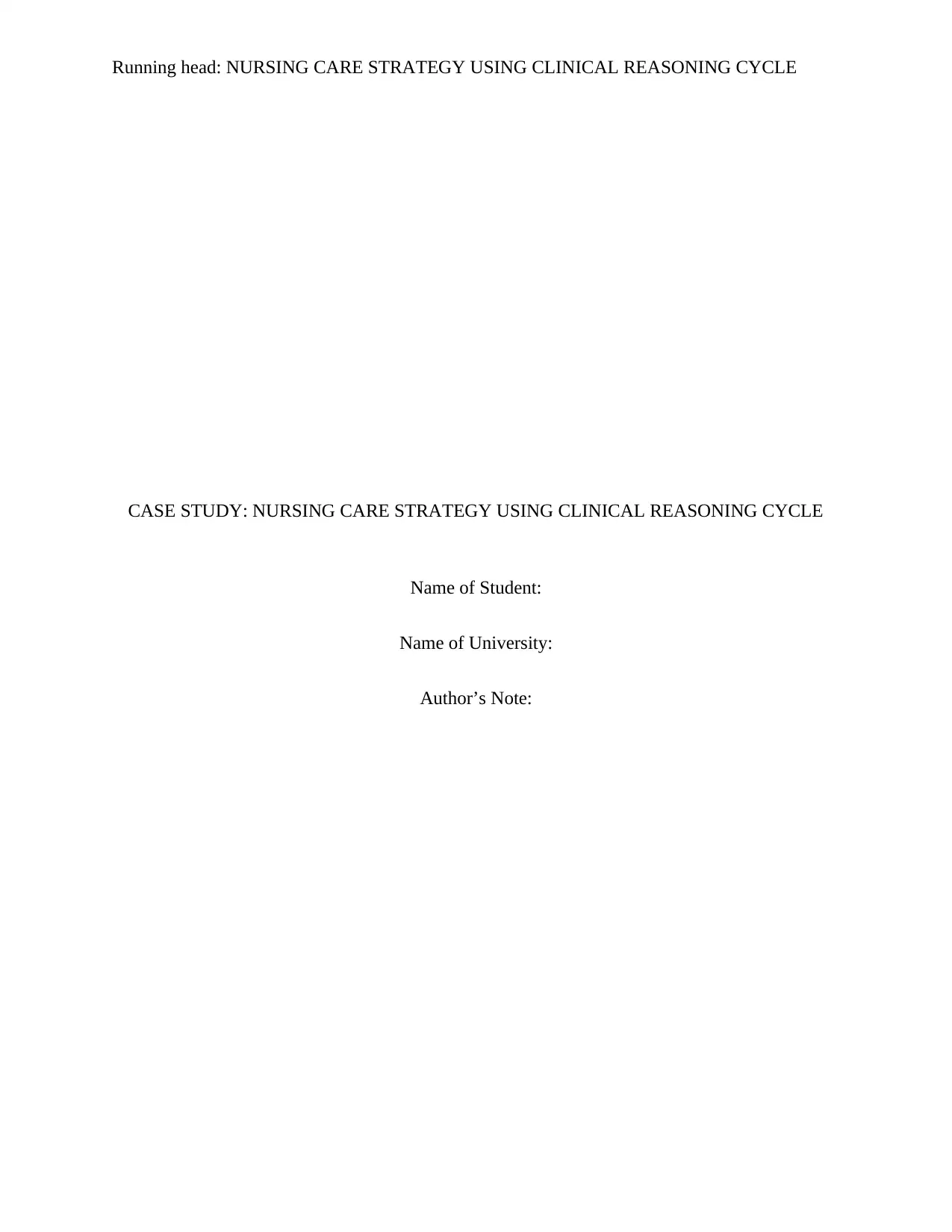
Running head: NURSING CARE STRATEGY USING CLINICAL REASONING CYCLE
CASE STUDY: NURSING CARE STRATEGY USING CLINICAL REASONING CYCLE
Name of Student:
Name of University:
Author’s Note:
CASE STUDY: NURSING CARE STRATEGY USING CLINICAL REASONING CYCLE
Name of Student:
Name of University:
Author’s Note:
Secure Best Marks with AI Grader
Need help grading? Try our AI Grader for instant feedback on your assignments.
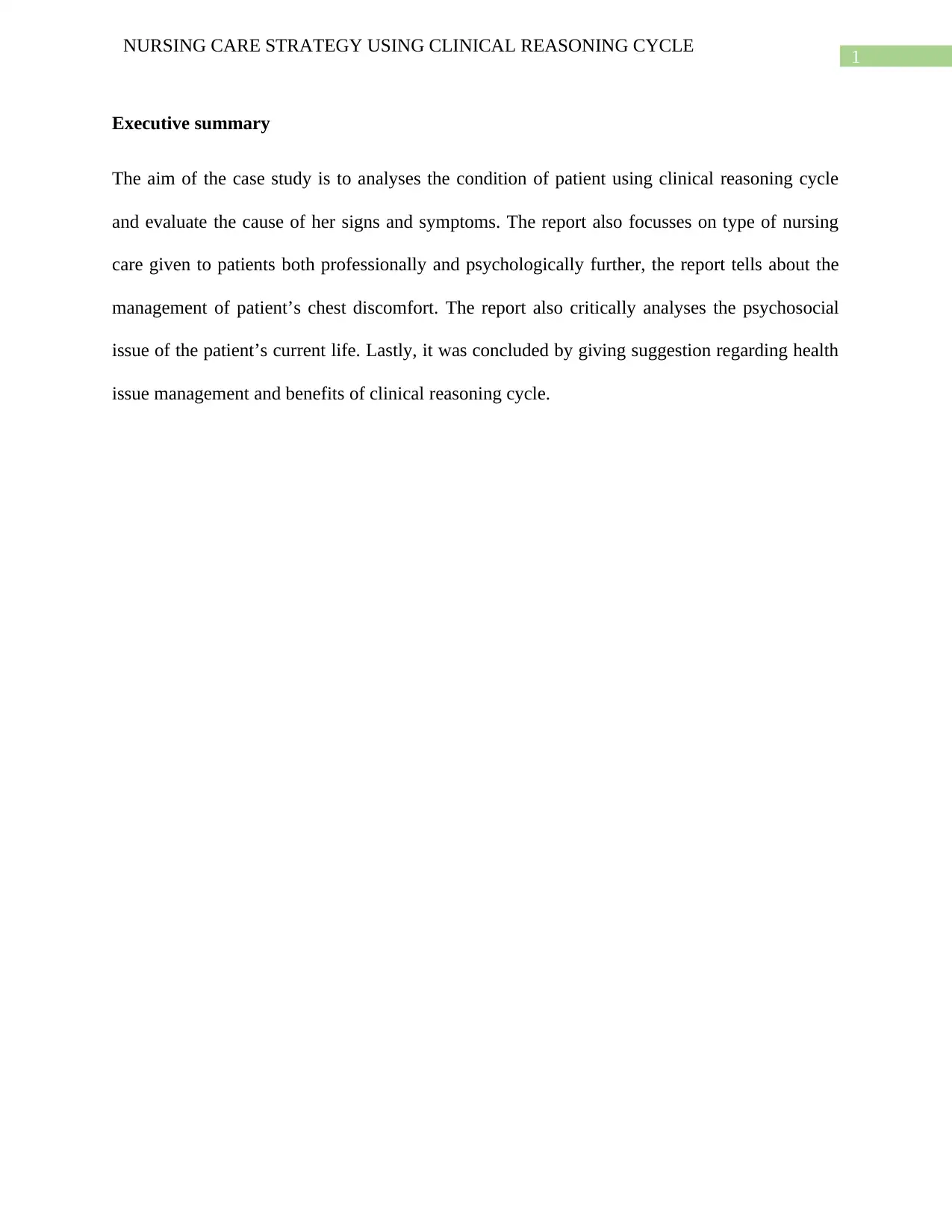
1
NURSING CARE STRATEGY USING CLINICAL REASONING CYCLE
Executive summary
The aim of the case study is to analyses the condition of patient using clinical reasoning cycle
and evaluate the cause of her signs and symptoms. The report also focusses on type of nursing
care given to patients both professionally and psychologically further, the report tells about the
management of patient’s chest discomfort. The report also critically analyses the psychosocial
issue of the patient’s current life. Lastly, it was concluded by giving suggestion regarding health
issue management and benefits of clinical reasoning cycle.
NURSING CARE STRATEGY USING CLINICAL REASONING CYCLE
Executive summary
The aim of the case study is to analyses the condition of patient using clinical reasoning cycle
and evaluate the cause of her signs and symptoms. The report also focusses on type of nursing
care given to patients both professionally and psychologically further, the report tells about the
management of patient’s chest discomfort. The report also critically analyses the psychosocial
issue of the patient’s current life. Lastly, it was concluded by giving suggestion regarding health
issue management and benefits of clinical reasoning cycle.
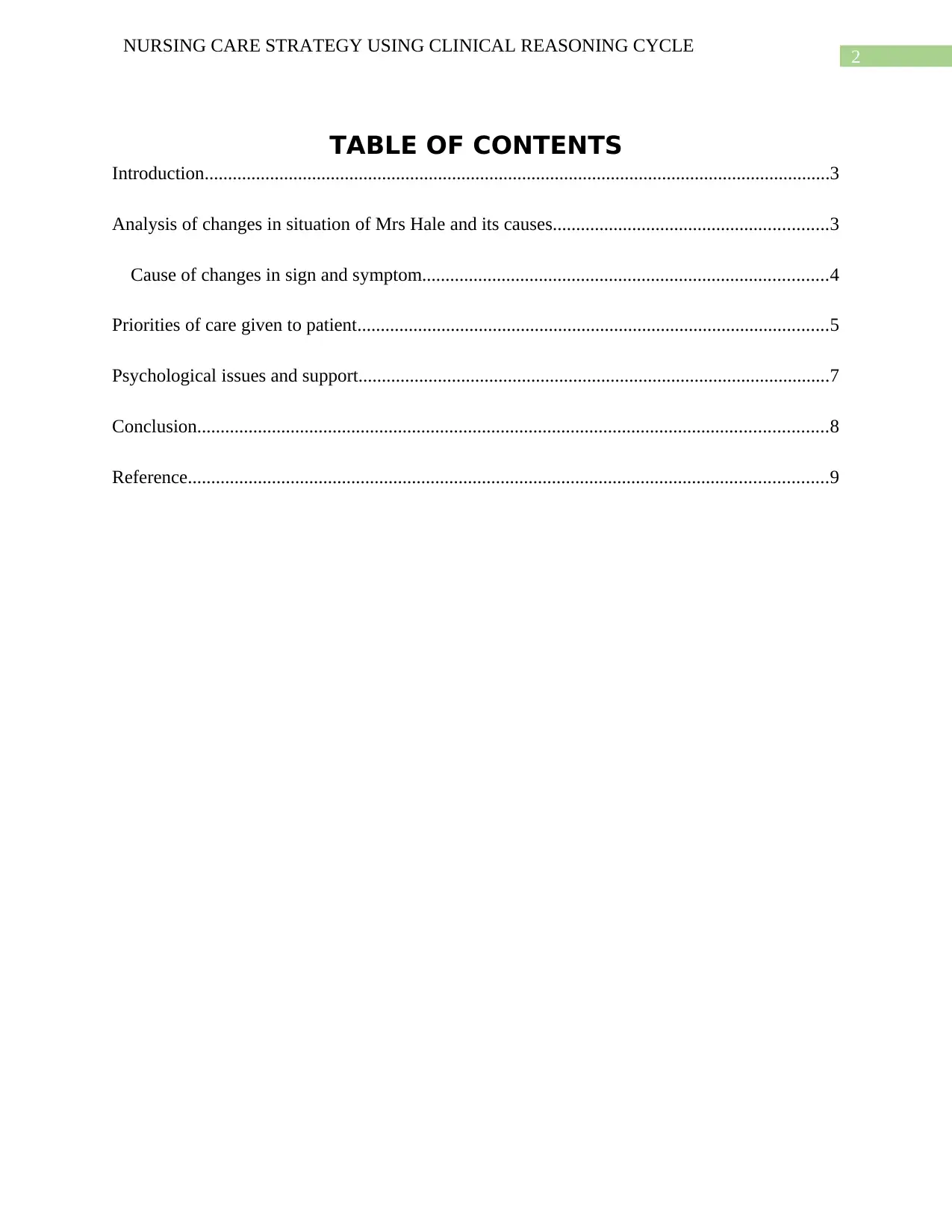
2
NURSING CARE STRATEGY USING CLINICAL REASONING CYCLE
TABLE OF CONTENTS
Introduction......................................................................................................................................3
Analysis of changes in situation of Mrs Hale and its causes...........................................................3
Cause of changes in sign and symptom.......................................................................................4
Priorities of care given to patient.....................................................................................................5
Psychological issues and support.....................................................................................................7
Conclusion.......................................................................................................................................8
Reference.........................................................................................................................................9
NURSING CARE STRATEGY USING CLINICAL REASONING CYCLE
TABLE OF CONTENTS
Introduction......................................................................................................................................3
Analysis of changes in situation of Mrs Hale and its causes...........................................................3
Cause of changes in sign and symptom.......................................................................................4
Priorities of care given to patient.....................................................................................................5
Psychological issues and support.....................................................................................................7
Conclusion.......................................................................................................................................8
Reference.........................................................................................................................................9
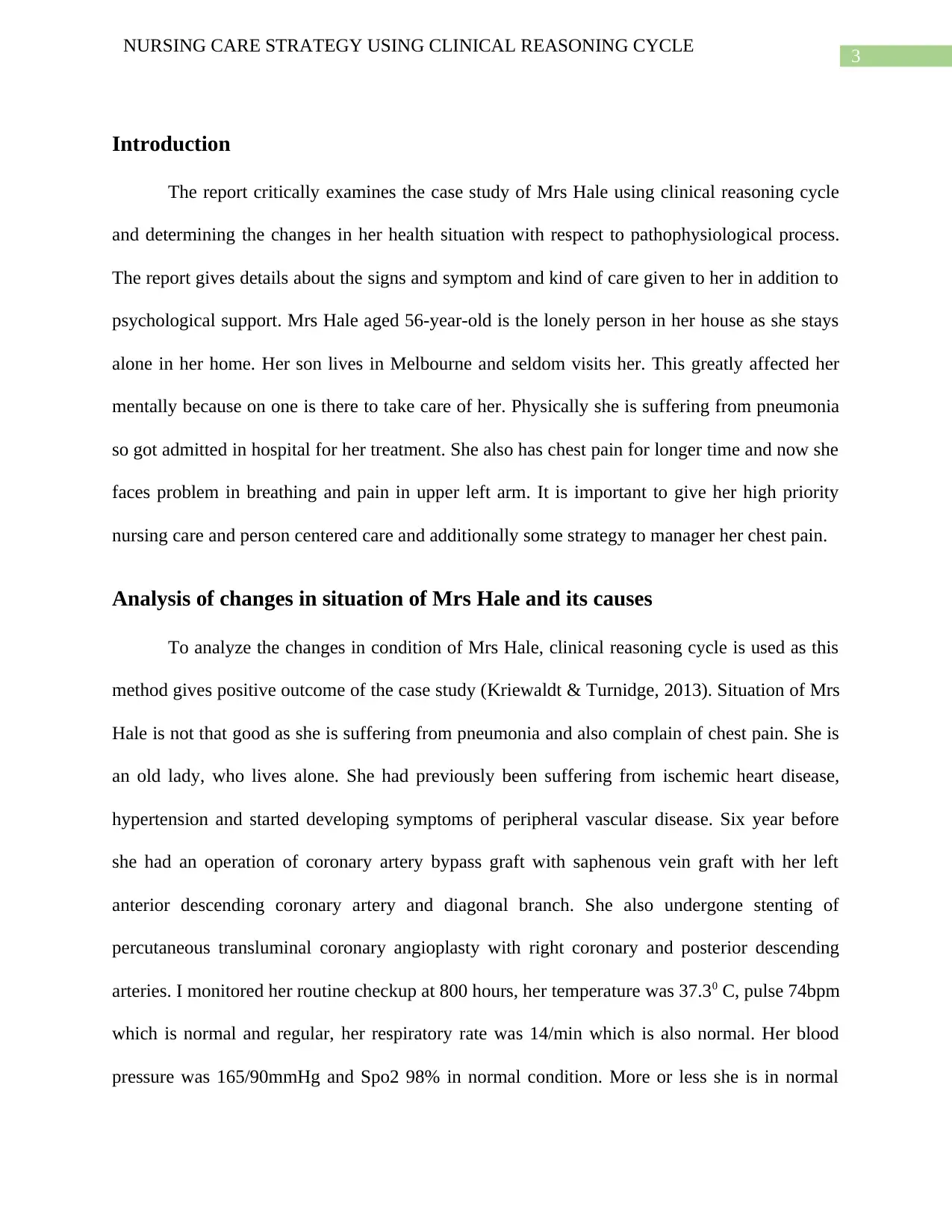
3
NURSING CARE STRATEGY USING CLINICAL REASONING CYCLE
Introduction
The report critically examines the case study of Mrs Hale using clinical reasoning cycle
and determining the changes in her health situation with respect to pathophysiological process.
The report gives details about the signs and symptom and kind of care given to her in addition to
psychological support. Mrs Hale aged 56-year-old is the lonely person in her house as she stays
alone in her home. Her son lives in Melbourne and seldom visits her. This greatly affected her
mentally because on one is there to take care of her. Physically she is suffering from pneumonia
so got admitted in hospital for her treatment. She also has chest pain for longer time and now she
faces problem in breathing and pain in upper left arm. It is important to give her high priority
nursing care and person centered care and additionally some strategy to manager her chest pain.
Analysis of changes in situation of Mrs Hale and its causes
To analyze the changes in condition of Mrs Hale, clinical reasoning cycle is used as this
method gives positive outcome of the case study (Kriewaldt & Turnidge, 2013). Situation of Mrs
Hale is not that good as she is suffering from pneumonia and also complain of chest pain. She is
an old lady, who lives alone. She had previously been suffering from ischemic heart disease,
hypertension and started developing symptoms of peripheral vascular disease. Six year before
she had an operation of coronary artery bypass graft with saphenous vein graft with her left
anterior descending coronary artery and diagonal branch. She also undergone stenting of
percutaneous transluminal coronary angioplasty with right coronary and posterior descending
arteries. I monitored her routine checkup at 800 hours, her temperature was 37.30 C, pulse 74bpm
which is normal and regular, her respiratory rate was 14/min which is also normal. Her blood
pressure was 165/90mmHg and Spo2 98% in normal condition. More or less she is in normal
NURSING CARE STRATEGY USING CLINICAL REASONING CYCLE
Introduction
The report critically examines the case study of Mrs Hale using clinical reasoning cycle
and determining the changes in her health situation with respect to pathophysiological process.
The report gives details about the signs and symptom and kind of care given to her in addition to
psychological support. Mrs Hale aged 56-year-old is the lonely person in her house as she stays
alone in her home. Her son lives in Melbourne and seldom visits her. This greatly affected her
mentally because on one is there to take care of her. Physically she is suffering from pneumonia
so got admitted in hospital for her treatment. She also has chest pain for longer time and now she
faces problem in breathing and pain in upper left arm. It is important to give her high priority
nursing care and person centered care and additionally some strategy to manager her chest pain.
Analysis of changes in situation of Mrs Hale and its causes
To analyze the changes in condition of Mrs Hale, clinical reasoning cycle is used as this
method gives positive outcome of the case study (Kriewaldt & Turnidge, 2013). Situation of Mrs
Hale is not that good as she is suffering from pneumonia and also complain of chest pain. She is
an old lady, who lives alone. She had previously been suffering from ischemic heart disease,
hypertension and started developing symptoms of peripheral vascular disease. Six year before
she had an operation of coronary artery bypass graft with saphenous vein graft with her left
anterior descending coronary artery and diagonal branch. She also undergone stenting of
percutaneous transluminal coronary angioplasty with right coronary and posterior descending
arteries. I monitored her routine checkup at 800 hours, her temperature was 37.30 C, pulse 74bpm
which is normal and regular, her respiratory rate was 14/min which is also normal. Her blood
pressure was 165/90mmHg and Spo2 98% in normal condition. More or less she is in normal
Secure Best Marks with AI Grader
Need help grading? Try our AI Grader for instant feedback on your assignments.
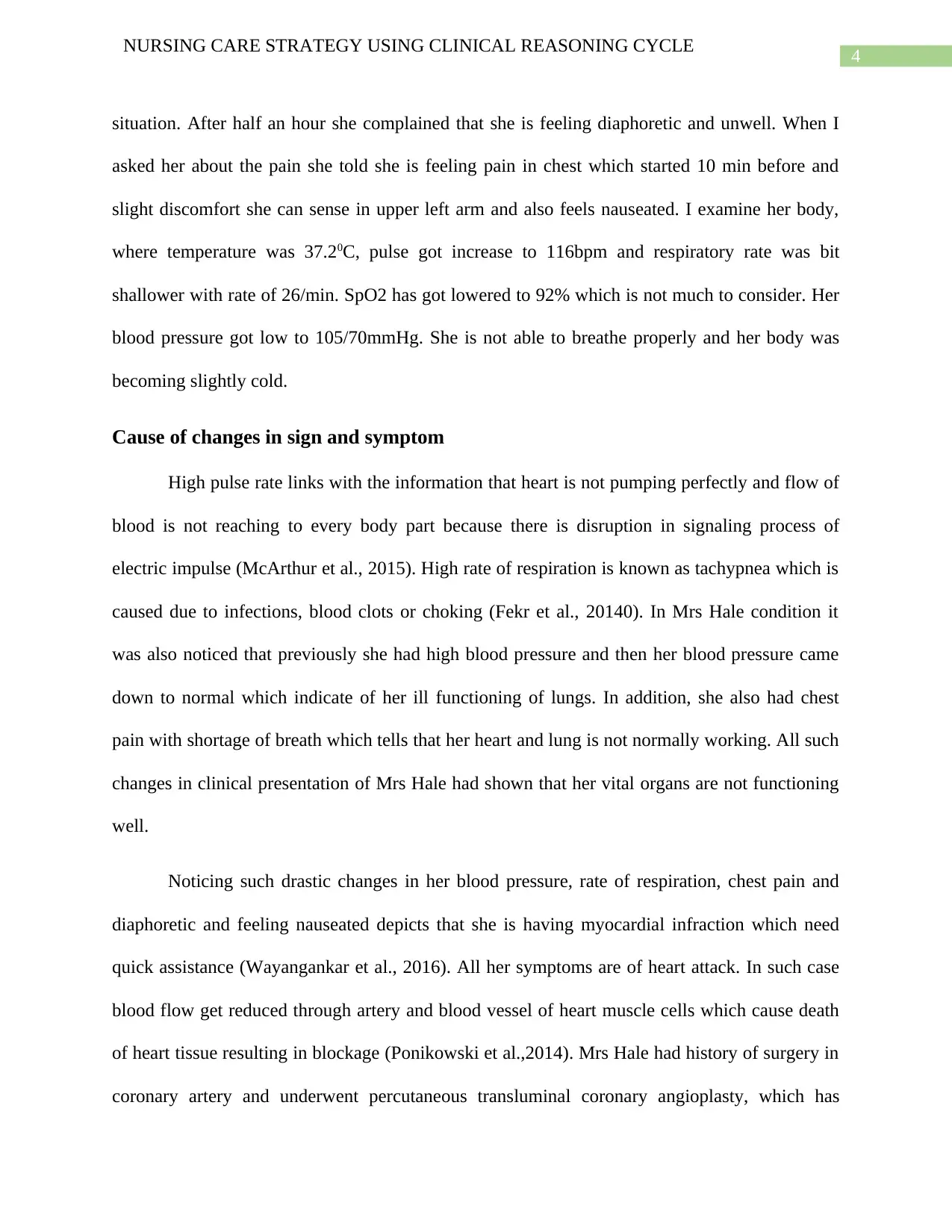
4
NURSING CARE STRATEGY USING CLINICAL REASONING CYCLE
situation. After half an hour she complained that she is feeling diaphoretic and unwell. When I
asked her about the pain she told she is feeling pain in chest which started 10 min before and
slight discomfort she can sense in upper left arm and also feels nauseated. I examine her body,
where temperature was 37.20C, pulse got increase to 116bpm and respiratory rate was bit
shallower with rate of 26/min. SpO2 has got lowered to 92% which is not much to consider. Her
blood pressure got low to 105/70mmHg. She is not able to breathe properly and her body was
becoming slightly cold.
Cause of changes in sign and symptom
High pulse rate links with the information that heart is not pumping perfectly and flow of
blood is not reaching to every body part because there is disruption in signaling process of
electric impulse (McArthur et al., 2015). High rate of respiration is known as tachypnea which is
caused due to infections, blood clots or choking (Fekr et al., 20140). In Mrs Hale condition it
was also noticed that previously she had high blood pressure and then her blood pressure came
down to normal which indicate of her ill functioning of lungs. In addition, she also had chest
pain with shortage of breath which tells that her heart and lung is not normally working. All such
changes in clinical presentation of Mrs Hale had shown that her vital organs are not functioning
well.
Noticing such drastic changes in her blood pressure, rate of respiration, chest pain and
diaphoretic and feeling nauseated depicts that she is having myocardial infraction which need
quick assistance (Wayangankar et al., 2016). All her symptoms are of heart attack. In such case
blood flow get reduced through artery and blood vessel of heart muscle cells which cause death
of heart tissue resulting in blockage (Ponikowski et al.,2014). Mrs Hale had history of surgery in
coronary artery and underwent percutaneous transluminal coronary angioplasty, which has
NURSING CARE STRATEGY USING CLINICAL REASONING CYCLE
situation. After half an hour she complained that she is feeling diaphoretic and unwell. When I
asked her about the pain she told she is feeling pain in chest which started 10 min before and
slight discomfort she can sense in upper left arm and also feels nauseated. I examine her body,
where temperature was 37.20C, pulse got increase to 116bpm and respiratory rate was bit
shallower with rate of 26/min. SpO2 has got lowered to 92% which is not much to consider. Her
blood pressure got low to 105/70mmHg. She is not able to breathe properly and her body was
becoming slightly cold.
Cause of changes in sign and symptom
High pulse rate links with the information that heart is not pumping perfectly and flow of
blood is not reaching to every body part because there is disruption in signaling process of
electric impulse (McArthur et al., 2015). High rate of respiration is known as tachypnea which is
caused due to infections, blood clots or choking (Fekr et al., 20140). In Mrs Hale condition it
was also noticed that previously she had high blood pressure and then her blood pressure came
down to normal which indicate of her ill functioning of lungs. In addition, she also had chest
pain with shortage of breath which tells that her heart and lung is not normally working. All such
changes in clinical presentation of Mrs Hale had shown that her vital organs are not functioning
well.
Noticing such drastic changes in her blood pressure, rate of respiration, chest pain and
diaphoretic and feeling nauseated depicts that she is having myocardial infraction which need
quick assistance (Wayangankar et al., 2016). All her symptoms are of heart attack. In such case
blood flow get reduced through artery and blood vessel of heart muscle cells which cause death
of heart tissue resulting in blockage (Ponikowski et al.,2014). Mrs Hale had history of surgery in
coronary artery and underwent percutaneous transluminal coronary angioplasty, which has
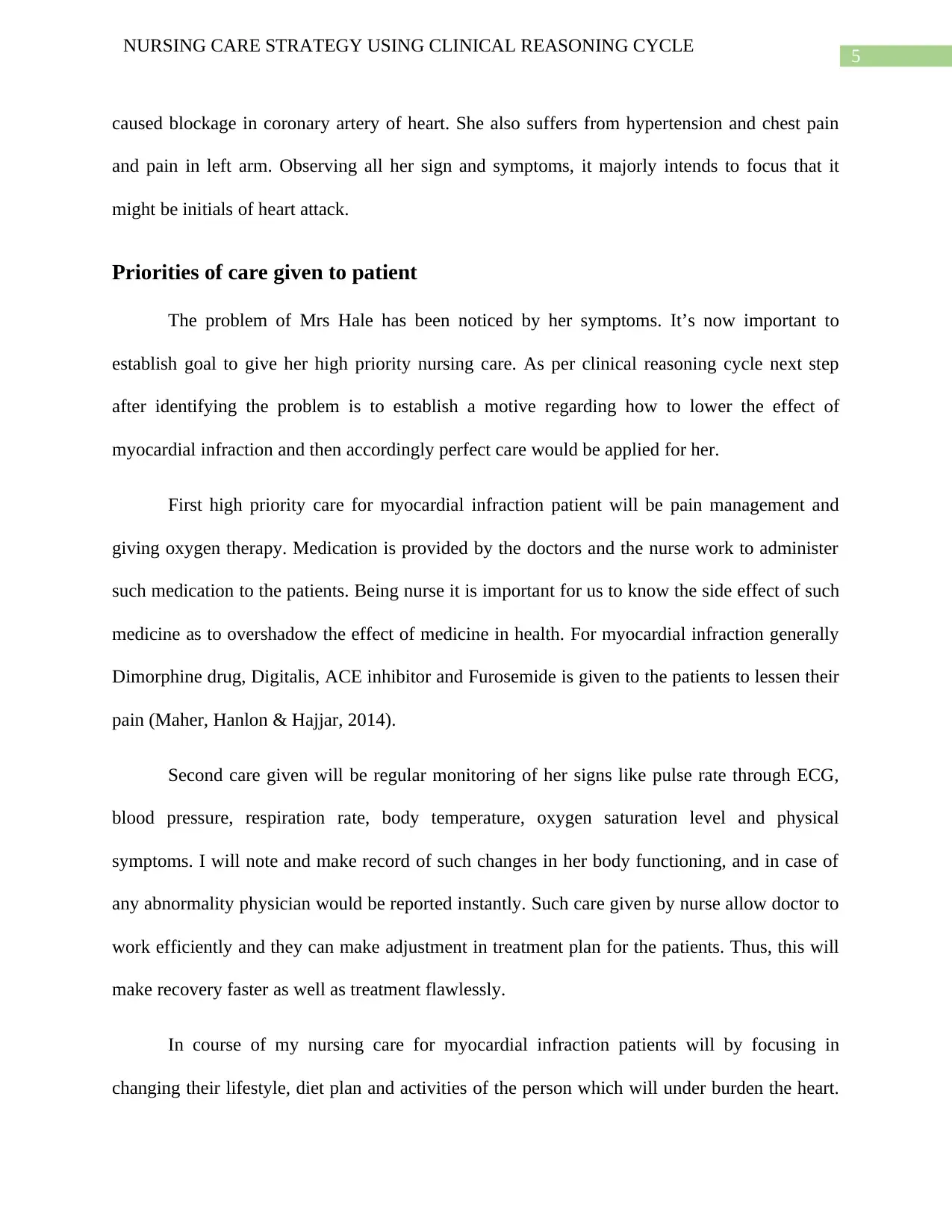
5
NURSING CARE STRATEGY USING CLINICAL REASONING CYCLE
caused blockage in coronary artery of heart. She also suffers from hypertension and chest pain
and pain in left arm. Observing all her sign and symptoms, it majorly intends to focus that it
might be initials of heart attack.
Priorities of care given to patient
The problem of Mrs Hale has been noticed by her symptoms. It’s now important to
establish goal to give her high priority nursing care. As per clinical reasoning cycle next step
after identifying the problem is to establish a motive regarding how to lower the effect of
myocardial infraction and then accordingly perfect care would be applied for her.
First high priority care for myocardial infraction patient will be pain management and
giving oxygen therapy. Medication is provided by the doctors and the nurse work to administer
such medication to the patients. Being nurse it is important for us to know the side effect of such
medicine as to overshadow the effect of medicine in health. For myocardial infraction generally
Dimorphine drug, Digitalis, ACE inhibitor and Furosemide is given to the patients to lessen their
pain (Maher, Hanlon & Hajjar, 2014).
Second care given will be regular monitoring of her signs like pulse rate through ECG,
blood pressure, respiration rate, body temperature, oxygen saturation level and physical
symptoms. I will note and make record of such changes in her body functioning, and in case of
any abnormality physician would be reported instantly. Such care given by nurse allow doctor to
work efficiently and they can make adjustment in treatment plan for the patients. Thus, this will
make recovery faster as well as treatment flawlessly.
In course of my nursing care for myocardial infraction patients will by focusing in
changing their lifestyle, diet plan and activities of the person which will under burden the heart.
NURSING CARE STRATEGY USING CLINICAL REASONING CYCLE
caused blockage in coronary artery of heart. She also suffers from hypertension and chest pain
and pain in left arm. Observing all her sign and symptoms, it majorly intends to focus that it
might be initials of heart attack.
Priorities of care given to patient
The problem of Mrs Hale has been noticed by her symptoms. It’s now important to
establish goal to give her high priority nursing care. As per clinical reasoning cycle next step
after identifying the problem is to establish a motive regarding how to lower the effect of
myocardial infraction and then accordingly perfect care would be applied for her.
First high priority care for myocardial infraction patient will be pain management and
giving oxygen therapy. Medication is provided by the doctors and the nurse work to administer
such medication to the patients. Being nurse it is important for us to know the side effect of such
medicine as to overshadow the effect of medicine in health. For myocardial infraction generally
Dimorphine drug, Digitalis, ACE inhibitor and Furosemide is given to the patients to lessen their
pain (Maher, Hanlon & Hajjar, 2014).
Second care given will be regular monitoring of her signs like pulse rate through ECG,
blood pressure, respiration rate, body temperature, oxygen saturation level and physical
symptoms. I will note and make record of such changes in her body functioning, and in case of
any abnormality physician would be reported instantly. Such care given by nurse allow doctor to
work efficiently and they can make adjustment in treatment plan for the patients. Thus, this will
make recovery faster as well as treatment flawlessly.
In course of my nursing care for myocardial infraction patients will by focusing in
changing their lifestyle, diet plan and activities of the person which will under burden the heart.
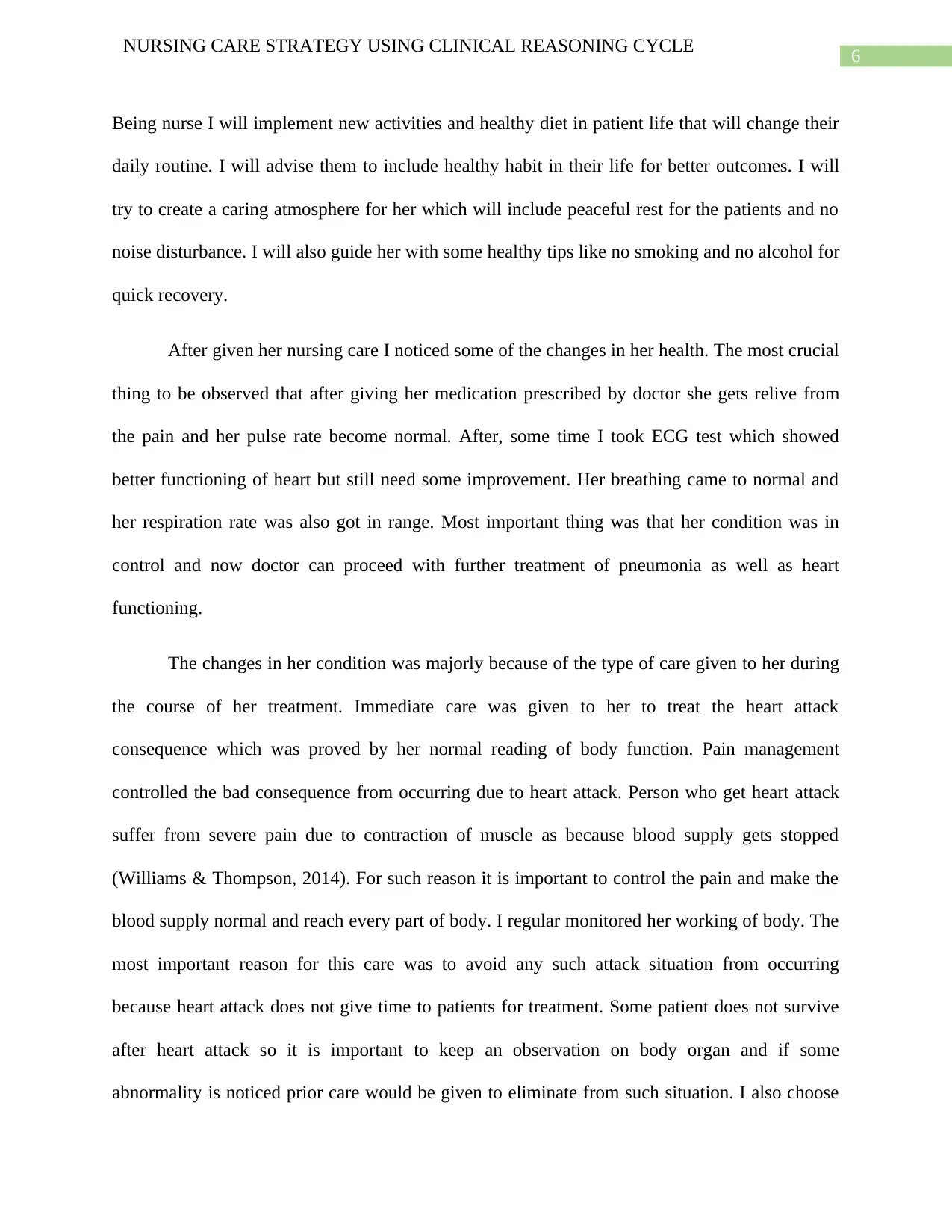
6
NURSING CARE STRATEGY USING CLINICAL REASONING CYCLE
Being nurse I will implement new activities and healthy diet in patient life that will change their
daily routine. I will advise them to include healthy habit in their life for better outcomes. I will
try to create a caring atmosphere for her which will include peaceful rest for the patients and no
noise disturbance. I will also guide her with some healthy tips like no smoking and no alcohol for
quick recovery.
After given her nursing care I noticed some of the changes in her health. The most crucial
thing to be observed that after giving her medication prescribed by doctor she gets relive from
the pain and her pulse rate become normal. After, some time I took ECG test which showed
better functioning of heart but still need some improvement. Her breathing came to normal and
her respiration rate was also got in range. Most important thing was that her condition was in
control and now doctor can proceed with further treatment of pneumonia as well as heart
functioning.
The changes in her condition was majorly because of the type of care given to her during
the course of her treatment. Immediate care was given to her to treat the heart attack
consequence which was proved by her normal reading of body function. Pain management
controlled the bad consequence from occurring due to heart attack. Person who get heart attack
suffer from severe pain due to contraction of muscle as because blood supply gets stopped
(Williams & Thompson, 2014). For such reason it is important to control the pain and make the
blood supply normal and reach every part of body. I regular monitored her working of body. The
most important reason for this care was to avoid any such attack situation from occurring
because heart attack does not give time to patients for treatment. Some patient does not survive
after heart attack so it is important to keep an observation on body organ and if some
abnormality is noticed prior care would be given to eliminate from such situation. I also choose
NURSING CARE STRATEGY USING CLINICAL REASONING CYCLE
Being nurse I will implement new activities and healthy diet in patient life that will change their
daily routine. I will advise them to include healthy habit in their life for better outcomes. I will
try to create a caring atmosphere for her which will include peaceful rest for the patients and no
noise disturbance. I will also guide her with some healthy tips like no smoking and no alcohol for
quick recovery.
After given her nursing care I noticed some of the changes in her health. The most crucial
thing to be observed that after giving her medication prescribed by doctor she gets relive from
the pain and her pulse rate become normal. After, some time I took ECG test which showed
better functioning of heart but still need some improvement. Her breathing came to normal and
her respiration rate was also got in range. Most important thing was that her condition was in
control and now doctor can proceed with further treatment of pneumonia as well as heart
functioning.
The changes in her condition was majorly because of the type of care given to her during
the course of her treatment. Immediate care was given to her to treat the heart attack
consequence which was proved by her normal reading of body function. Pain management
controlled the bad consequence from occurring due to heart attack. Person who get heart attack
suffer from severe pain due to contraction of muscle as because blood supply gets stopped
(Williams & Thompson, 2014). For such reason it is important to control the pain and make the
blood supply normal and reach every part of body. I regular monitored her working of body. The
most important reason for this care was to avoid any such attack situation from occurring
because heart attack does not give time to patients for treatment. Some patient does not survive
after heart attack so it is important to keep an observation on body organ and if some
abnormality is noticed prior care would be given to eliminate from such situation. I also choose
Paraphrase This Document
Need a fresh take? Get an instant paraphrase of this document with our AI Paraphraser
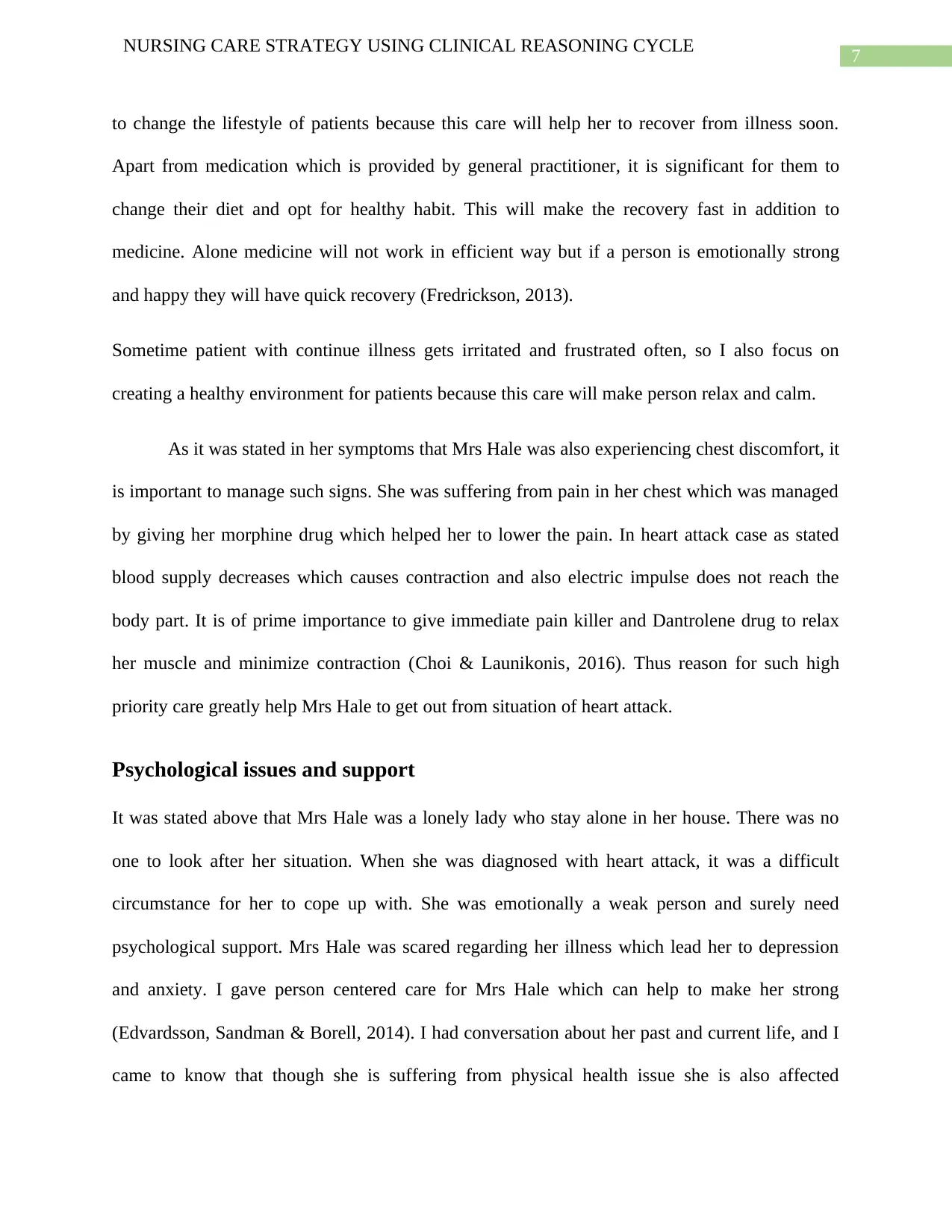
7
NURSING CARE STRATEGY USING CLINICAL REASONING CYCLE
to change the lifestyle of patients because this care will help her to recover from illness soon.
Apart from medication which is provided by general practitioner, it is significant for them to
change their diet and opt for healthy habit. This will make the recovery fast in addition to
medicine. Alone medicine will not work in efficient way but if a person is emotionally strong
and happy they will have quick recovery (Fredrickson, 2013).
Sometime patient with continue illness gets irritated and frustrated often, so I also focus on
creating a healthy environment for patients because this care will make person relax and calm.
As it was stated in her symptoms that Mrs Hale was also experiencing chest discomfort, it
is important to manage such signs. She was suffering from pain in her chest which was managed
by giving her morphine drug which helped her to lower the pain. In heart attack case as stated
blood supply decreases which causes contraction and also electric impulse does not reach the
body part. It is of prime importance to give immediate pain killer and Dantrolene drug to relax
her muscle and minimize contraction (Choi & Launikonis, 2016). Thus reason for such high
priority care greatly help Mrs Hale to get out from situation of heart attack.
Psychological issues and support
It was stated above that Mrs Hale was a lonely lady who stay alone in her house. There was no
one to look after her situation. When she was diagnosed with heart attack, it was a difficult
circumstance for her to cope up with. She was emotionally a weak person and surely need
psychological support. Mrs Hale was scared regarding her illness which lead her to depression
and anxiety. I gave person centered care for Mrs Hale which can help to make her strong
(Edvardsson, Sandman & Borell, 2014). I had conversation about her past and current life, and I
came to know that though she is suffering from physical health issue she is also affected
NURSING CARE STRATEGY USING CLINICAL REASONING CYCLE
to change the lifestyle of patients because this care will help her to recover from illness soon.
Apart from medication which is provided by general practitioner, it is significant for them to
change their diet and opt for healthy habit. This will make the recovery fast in addition to
medicine. Alone medicine will not work in efficient way but if a person is emotionally strong
and happy they will have quick recovery (Fredrickson, 2013).
Sometime patient with continue illness gets irritated and frustrated often, so I also focus on
creating a healthy environment for patients because this care will make person relax and calm.
As it was stated in her symptoms that Mrs Hale was also experiencing chest discomfort, it
is important to manage such signs. She was suffering from pain in her chest which was managed
by giving her morphine drug which helped her to lower the pain. In heart attack case as stated
blood supply decreases which causes contraction and also electric impulse does not reach the
body part. It is of prime importance to give immediate pain killer and Dantrolene drug to relax
her muscle and minimize contraction (Choi & Launikonis, 2016). Thus reason for such high
priority care greatly help Mrs Hale to get out from situation of heart attack.
Psychological issues and support
It was stated above that Mrs Hale was a lonely lady who stay alone in her house. There was no
one to look after her situation. When she was diagnosed with heart attack, it was a difficult
circumstance for her to cope up with. She was emotionally a weak person and surely need
psychological support. Mrs Hale was scared regarding her illness which lead her to depression
and anxiety. I gave person centered care for Mrs Hale which can help to make her strong
(Edvardsson, Sandman & Borell, 2014). I had conversation about her past and current life, and I
came to know that though she is suffering from physical health issue she is also affected
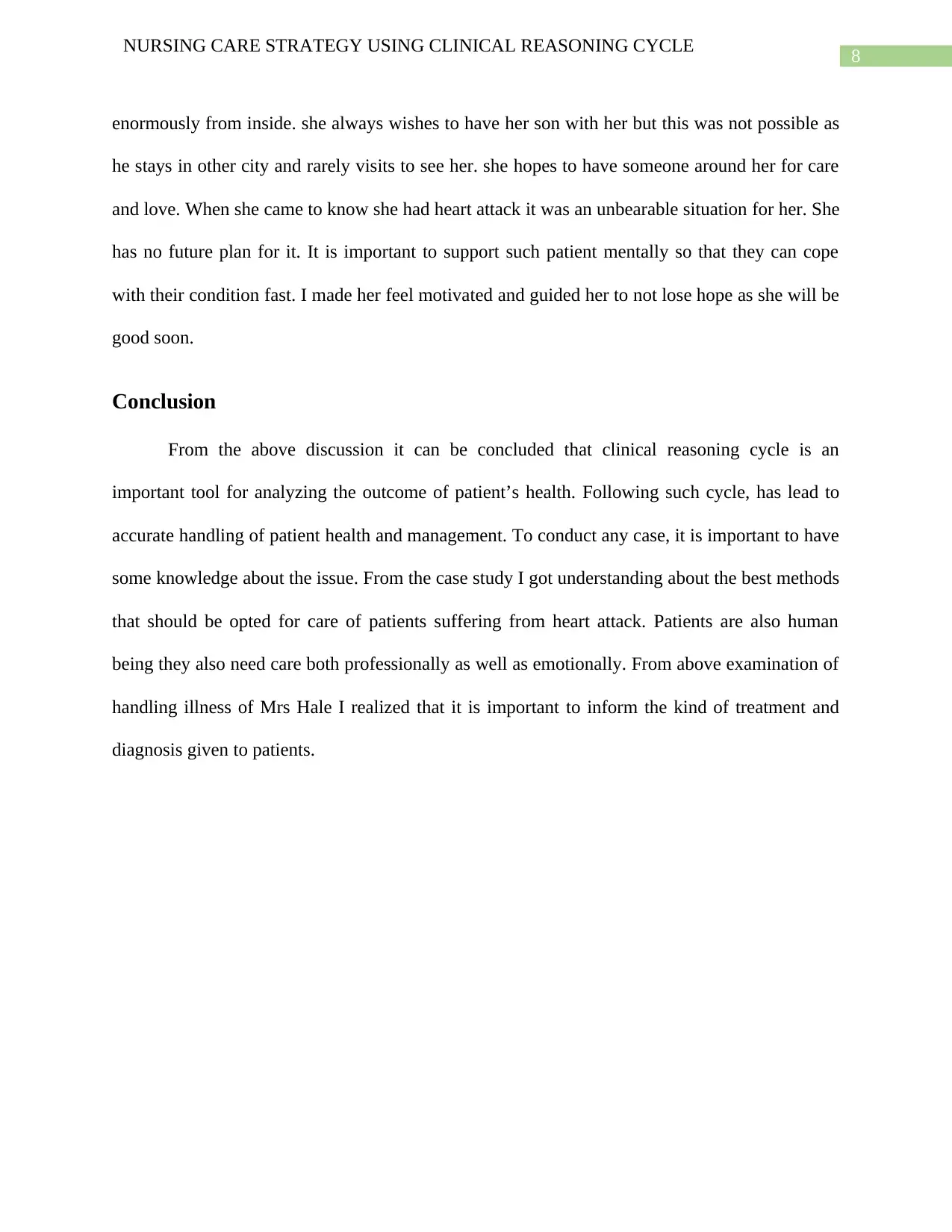
8
NURSING CARE STRATEGY USING CLINICAL REASONING CYCLE
enormously from inside. she always wishes to have her son with her but this was not possible as
he stays in other city and rarely visits to see her. she hopes to have someone around her for care
and love. When she came to know she had heart attack it was an unbearable situation for her. She
has no future plan for it. It is important to support such patient mentally so that they can cope
with their condition fast. I made her feel motivated and guided her to not lose hope as she will be
good soon.
Conclusion
From the above discussion it can be concluded that clinical reasoning cycle is an
important tool for analyzing the outcome of patient’s health. Following such cycle, has lead to
accurate handling of patient health and management. To conduct any case, it is important to have
some knowledge about the issue. From the case study I got understanding about the best methods
that should be opted for care of patients suffering from heart attack. Patients are also human
being they also need care both professionally as well as emotionally. From above examination of
handling illness of Mrs Hale I realized that it is important to inform the kind of treatment and
diagnosis given to patients.
NURSING CARE STRATEGY USING CLINICAL REASONING CYCLE
enormously from inside. she always wishes to have her son with her but this was not possible as
he stays in other city and rarely visits to see her. she hopes to have someone around her for care
and love. When she came to know she had heart attack it was an unbearable situation for her. She
has no future plan for it. It is important to support such patient mentally so that they can cope
with their condition fast. I made her feel motivated and guided her to not lose hope as she will be
good soon.
Conclusion
From the above discussion it can be concluded that clinical reasoning cycle is an
important tool for analyzing the outcome of patient’s health. Following such cycle, has lead to
accurate handling of patient health and management. To conduct any case, it is important to have
some knowledge about the issue. From the case study I got understanding about the best methods
that should be opted for care of patients suffering from heart attack. Patients are also human
being they also need care both professionally as well as emotionally. From above examination of
handling illness of Mrs Hale I realized that it is important to inform the kind of treatment and
diagnosis given to patients.
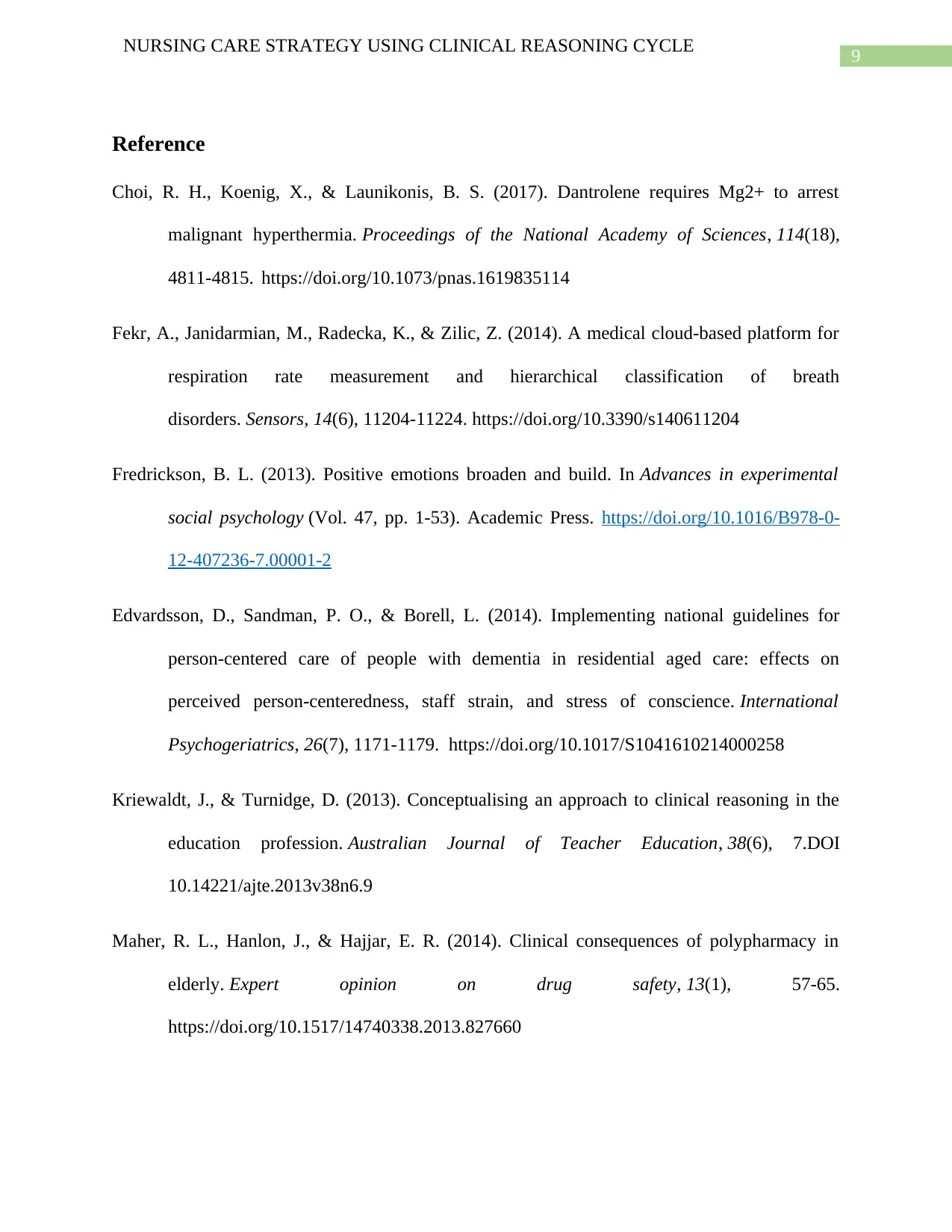
9
NURSING CARE STRATEGY USING CLINICAL REASONING CYCLE
Reference
Choi, R. H., Koenig, X., & Launikonis, B. S. (2017). Dantrolene requires Mg2+ to arrest
malignant hyperthermia. Proceedings of the National Academy of Sciences, 114(18),
4811-4815. https://doi.org/10.1073/pnas.1619835114
Fekr, A., Janidarmian, M., Radecka, K., & Zilic, Z. (2014). A medical cloud-based platform for
respiration rate measurement and hierarchical classification of breath
disorders. Sensors, 14(6), 11204-11224. https://doi.org/10.3390/s140611204
Fredrickson, B. L. (2013). Positive emotions broaden and build. In Advances in experimental
social psychology (Vol. 47, pp. 1-53). Academic Press. https://doi.org/10.1016/B978-0-
12-407236-7.00001-2
Edvardsson, D., Sandman, P. O., & Borell, L. (2014). Implementing national guidelines for
person-centered care of people with dementia in residential aged care: effects on
perceived person-centeredness, staff strain, and stress of conscience. International
Psychogeriatrics, 26(7), 1171-1179. https://doi.org/10.1017/S1041610214000258
Kriewaldt, J., & Turnidge, D. (2013). Conceptualising an approach to clinical reasoning in the
education profession. Australian Journal of Teacher Education, 38(6), 7.DOI
10.14221/ajte.2013v38n6.9
Maher, R. L., Hanlon, J., & Hajjar, E. R. (2014). Clinical consequences of polypharmacy in
elderly. Expert opinion on drug safety, 13(1), 57-65.
https://doi.org/10.1517/14740338.2013.827660
NURSING CARE STRATEGY USING CLINICAL REASONING CYCLE
Reference
Choi, R. H., Koenig, X., & Launikonis, B. S. (2017). Dantrolene requires Mg2+ to arrest
malignant hyperthermia. Proceedings of the National Academy of Sciences, 114(18),
4811-4815. https://doi.org/10.1073/pnas.1619835114
Fekr, A., Janidarmian, M., Radecka, K., & Zilic, Z. (2014). A medical cloud-based platform for
respiration rate measurement and hierarchical classification of breath
disorders. Sensors, 14(6), 11204-11224. https://doi.org/10.3390/s140611204
Fredrickson, B. L. (2013). Positive emotions broaden and build. In Advances in experimental
social psychology (Vol. 47, pp. 1-53). Academic Press. https://doi.org/10.1016/B978-0-
12-407236-7.00001-2
Edvardsson, D., Sandman, P. O., & Borell, L. (2014). Implementing national guidelines for
person-centered care of people with dementia in residential aged care: effects on
perceived person-centeredness, staff strain, and stress of conscience. International
Psychogeriatrics, 26(7), 1171-1179. https://doi.org/10.1017/S1041610214000258
Kriewaldt, J., & Turnidge, D. (2013). Conceptualising an approach to clinical reasoning in the
education profession. Australian Journal of Teacher Education, 38(6), 7.DOI
10.14221/ajte.2013v38n6.9
Maher, R. L., Hanlon, J., & Hajjar, E. R. (2014). Clinical consequences of polypharmacy in
elderly. Expert opinion on drug safety, 13(1), 57-65.
https://doi.org/10.1517/14740338.2013.827660
Secure Best Marks with AI Grader
Need help grading? Try our AI Grader for instant feedback on your assignments.
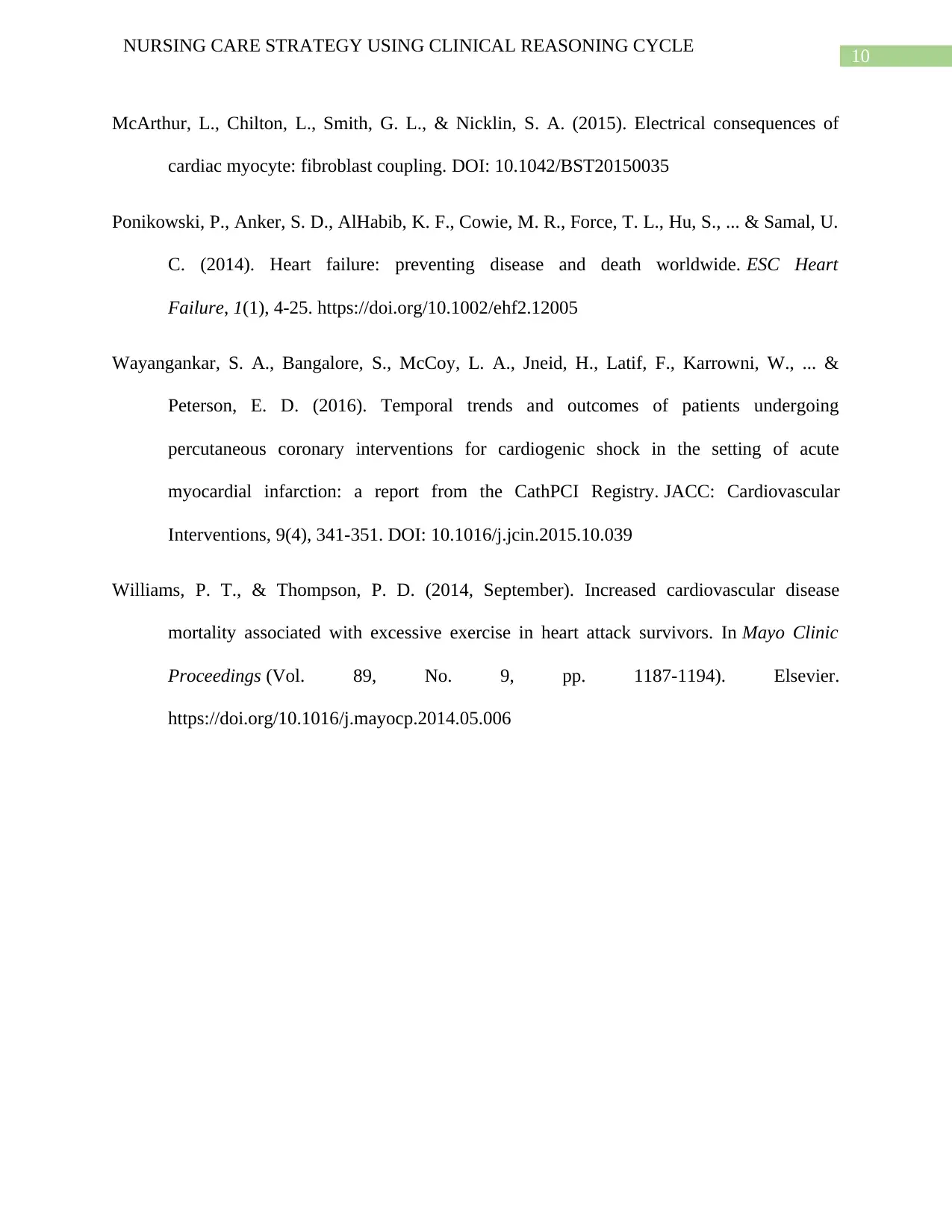
10
NURSING CARE STRATEGY USING CLINICAL REASONING CYCLE
McArthur, L., Chilton, L., Smith, G. L., & Nicklin, S. A. (2015). Electrical consequences of
cardiac myocyte: fibroblast coupling. DOI: 10.1042/BST20150035
Ponikowski, P., Anker, S. D., AlHabib, K. F., Cowie, M. R., Force, T. L., Hu, S., ... & Samal, U.
C. (2014). Heart failure: preventing disease and death worldwide. ESC Heart
Failure, 1(1), 4-25. https://doi.org/10.1002/ehf2.12005
Wayangankar, S. A., Bangalore, S., McCoy, L. A., Jneid, H., Latif, F., Karrowni, W., ... &
Peterson, E. D. (2016). Temporal trends and outcomes of patients undergoing
percutaneous coronary interventions for cardiogenic shock in the setting of acute
myocardial infarction: a report from the CathPCI Registry. JACC: Cardiovascular
Interventions, 9(4), 341-351. DOI: 10.1016/j.jcin.2015.10.039
Williams, P. T., & Thompson, P. D. (2014, September). Increased cardiovascular disease
mortality associated with excessive exercise in heart attack survivors. In Mayo Clinic
Proceedings (Vol. 89, No. 9, pp. 1187-1194). Elsevier.
https://doi.org/10.1016/j.mayocp.2014.05.006
NURSING CARE STRATEGY USING CLINICAL REASONING CYCLE
McArthur, L., Chilton, L., Smith, G. L., & Nicklin, S. A. (2015). Electrical consequences of
cardiac myocyte: fibroblast coupling. DOI: 10.1042/BST20150035
Ponikowski, P., Anker, S. D., AlHabib, K. F., Cowie, M. R., Force, T. L., Hu, S., ... & Samal, U.
C. (2014). Heart failure: preventing disease and death worldwide. ESC Heart
Failure, 1(1), 4-25. https://doi.org/10.1002/ehf2.12005
Wayangankar, S. A., Bangalore, S., McCoy, L. A., Jneid, H., Latif, F., Karrowni, W., ... &
Peterson, E. D. (2016). Temporal trends and outcomes of patients undergoing
percutaneous coronary interventions for cardiogenic shock in the setting of acute
myocardial infarction: a report from the CathPCI Registry. JACC: Cardiovascular
Interventions, 9(4), 341-351. DOI: 10.1016/j.jcin.2015.10.039
Williams, P. T., & Thompson, P. D. (2014, September). Increased cardiovascular disease
mortality associated with excessive exercise in heart attack survivors. In Mayo Clinic
Proceedings (Vol. 89, No. 9, pp. 1187-1194). Elsevier.
https://doi.org/10.1016/j.mayocp.2014.05.006
1 out of 11
Related Documents
Your All-in-One AI-Powered Toolkit for Academic Success.
+13062052269
info@desklib.com
Available 24*7 on WhatsApp / Email
![[object Object]](/_next/static/media/star-bottom.7253800d.svg)
Unlock your academic potential
© 2024 | Zucol Services PVT LTD | All rights reserved.





